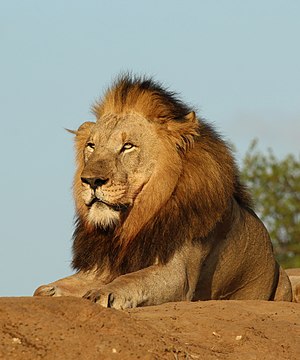The lion (Panthera leo) is a large cat of the genus Panthera native to Africa and India. It has a muscular, broad-chested body, short, rounded head, round ears, and a hairy tuft at the end of its tail. It is sexually dimorphic; adult male lions are larger than females and have a prominent mane. It is a social species, forming groups called prides. A lion's pride consists of a few adult males, related females, and cubs. Groups of female lions usually hunt together, preying mostly on large ungulates. The lion is an apex and keystone predator; although some lions scavenge when opportunities occur and have been known to hunt humans, the species typically does not actively seek out and prey on humans.
In the 19th and 20th centuries, several lion type specimens were described and proposed as subspecies, with about a dozen recognised as valid taxa until 2017. Between 2008 and 2016, IUCN Red List assessors used only two subspecific names: P. l. leo for African lion populations, and P. l. persica for the Asiatic lion population. In 2017, the Cat Classification Task Force of the Cat Specialist Group revised lion taxonomy, and recognises two subspecies based on results of several phylogeographic studies on lion evolution, namely:
1. P. l. leo (Linnaeus, 1758) − the nominate lion subspecies includes the Asiatic lion, the regionally extinct Barbary lion, and lion populations in West and northern parts of Central Africa. Synonyms include P. l. persica (Meyer, 1826), P. l. senegalensis (Meyer, 1826), P. l. kamptzi (Matschie, 1900), and P. l. azandica (Allen, 1924).[1] Multiple authors referred to it as 'northern lion' and 'northern subspecies'.
2. P. l. melanochaita (Smith, 1842) − includes the extinct Cape lion and lion populations in East and Southern African regions. Synonyms include P. l. somaliensis (Noack 1891), P. l. massaica (Neumann, 1900), P. l. sabakiensis (Lönnberg, 1910), P. l. bleyenberghi (Lönnberg, 1914), P. l. roosevelti (Heller, 1914), P. l. nyanzae (Heller, 1914), P. l. hollisteri (Allen, 1924), P. l. krugeri (Roberts, 1929), P. l. vernayi (Roberts, 1948), and P. l. webbiensis (Zukowsky, 1964). It has been referred to as 'southern subspecies' and 'southern lion'.
The Panthera lineage is estimated to have genetically diverged from the common ancestor of the Felidae around 9.32 to 4.47 million years ago to 11.75 to 0.97 million years ago, and the geographic origin of the genus is most likely northern Central Asia. Results of analyses differ in the phylogenetic relationship of the lion; it was thought to form a sister group with the jaguar (P. onca) that diverged 3.46 to 1.22 million years ago, but also with the leopard (P. pardus) that diverged 3.1 to 1.95 million years ago to 4.32 to 0.02 million years ago. Hybridisation between lion and snow leopard (P. uncia) ancestors possibly continued until about 2.1 million years ago. The lion-leopard clade was distributed in the Asian and African Palearctic since at least the early Pliocene. The earliest fossils recognisable as lions were found at Olduvai Gorge in Tanzania and are estimated to be up to 2 million years old.
Estimates for the divergence time of the modern and cave lion lineages range from 529,000 to 392,000 years ago based on mutation rate per generation time of the modern lion. There is no evidence for gene flow between the two lineages, indicating that they did not share the same geographic area. The Eurasian and American cave lions became extinct at the end of the last glacial period without mitochondrial descendants on other continents. The modern lion was probably widely distributed in Africa during the Middle Pleistocene and started to diverge in sub-Saharan Africa during the Late Pleistocene. Lion populations in East and Southern Africa became separated from populations in West and North Africa when the equatorial rainforest expanded 183,500 to 81,800 years ago. They shared a common ancestor probably between 98,000 and 52,000 years ago. Due to the expansion of the Sahara between 83,100 and 26,600 years ago, lion populations in West and North Africa became separated. As the rainforest decreased and thus gave rise to more open habitats, lions moved from West to Central Africa. Lions from North Africa dispersed to southern Europe and Asia between 38,800 and 8,300 years ago.
The lion is a muscular, broad-chested cat with a short, rounded head, a reduced neck and round ears. Its fur varies in colour from light buff to silvery grey, yellowish red and dark brown. The colours of the underparts are generally lighter. A new-born lion has dark spots, which fade as the cub reaches adulthood, although faint spots often may still be seen on the legs and underparts. The lion is the only member of the cat family that displays obvious sexual dimorphism. Males have broader heads and a prominent mane that grows downwards and backwards covering most of the head, neck, shoulders, and chest. The mane is typically brownish and tinged with yellow, rust and black hairs.
The tail of all lions ends in a dark, hairy tuft that in some lions conceals an approximately 5 mm (0.20 in)-long, hard "spine" or "spur" that is formed from the final, fused sections of tail bone. The functions of the spur are unknown. The tuft is absent at birth and develops at around 5+1⁄2 months of age. It is readily identifiable by the age of seven months.
| Average | Female lions | Male lions |
|---|---|---|
| Head-and-body length | 160–184 cm (63–72 in) | 184–208 cm (72–82 in) |
| Tail length | 72–89.5 cm (28.3–35.2 in) | 82.5–93.5 cm (32.5–36.8 in) |
| Weight | 118.37–143.52 kg (261.0–316.4 lb) in Southern Africa, 119.5 kg (263 lb) in East Africa, 110–120 kg (240–260 lb) in India |
186.55–225 kg (411.3–496.0 lb) in Southern Africa, 174.9 kg (386 lb) in East Africa, 160–190 kg (350–420 lb) in India |
